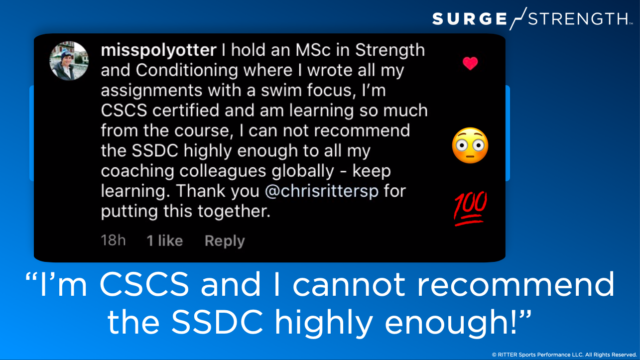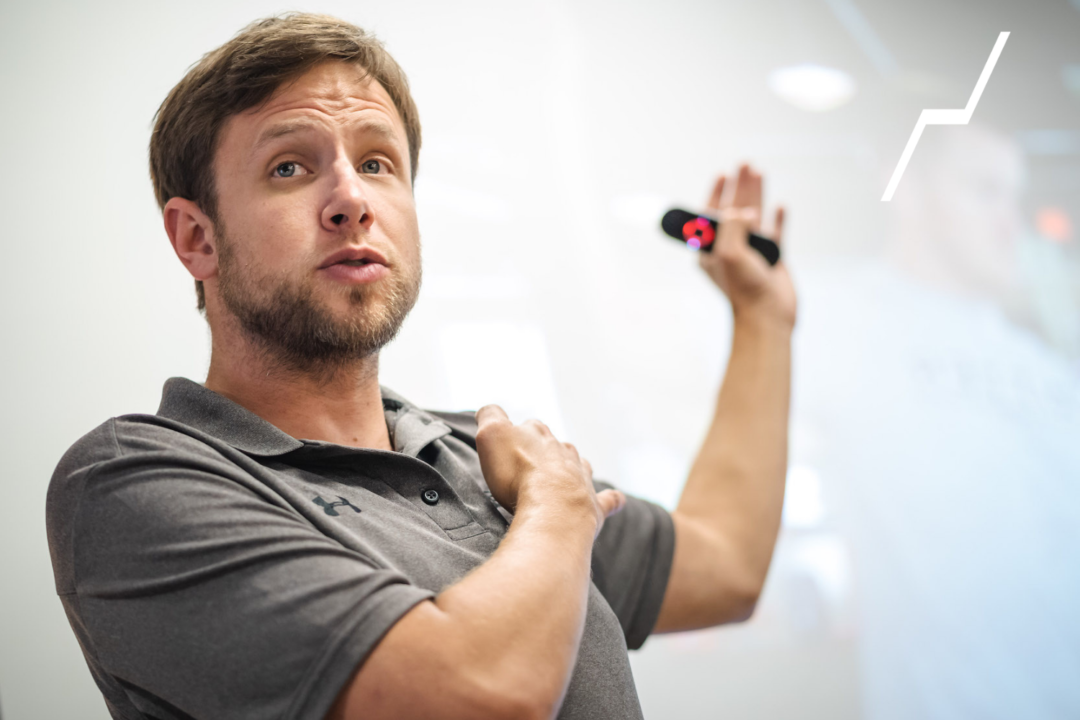Knowing how to prevent swimmer’s shoulder can be the holy grail of dryland training. This applies all the time, but especially when training ticks up a few notches during the season, such as when many coaches ramp up yardage. Because of this, swimmers oftentimes find themselves with nagging shoulder pain. Others get injured to the point of missing practice. Neither are conducive to fast swimming. In fact, one of our central missions at SURGE Strength is simply using dryland to keep swimmers available. Whether that be available to practice every day, available to practice harder, or available to keep pushing on day 3 of a meet, being available is KEY to building better athletes.
Our SURGE Strength Programs (which are created and implemented by four incredible Dryland Certified Coaches) take the preventative approach as the best way to fix shoulder pain in the first place. If you’ve prevented shoulder pain, there’s no cause for concern about whether your swimmer will be available in a week or a month to continue training. Essentially, through dryland training we implement shoulder rehabilitation exercises that bulletproof our swimmers’ shoulders which increases longevity in the sport.
- Want to Help Us Raise the Standard of Dryland Training? Learn More – Become SURGE Strength Dryland Certified (SSDC)
How to Prevent Swimmer’s Shoulder with Prehabilitation
What is Shoulder Prehabilitation?
Shoulder prehabilitation (prehab for short) is comprised of function exercises that mobilize, stabilize, and strengthen the muscles around the shoulder joint in order to prevent injury. More specifically, shoulder prehab prevents strain on the rotator cuff. It also keeps the ball of the humorous securely in the socket of the shoulder joint. Think of these exercises as “pre” rehab. In other words, exercises you would typically do in physical therapy that occur after an injury. Instead, by doing them before getting hurt, you can bulletproof your shoulders from even needing rehab.
- Function exercises: movement patterns designed to improve an athlete’s technique in a specific area of the body.
A proper shoulder prehab protocol includes movements for mobility, stability and strength. These exercises reduce a swimmer’s risk of shoulder impingement or strain. In turn, they also prevent inflammation around the shoulder joint. Overall, shoulder prehab helps the ball and socket joint remain intact. This allows swimmers to maintain a healthier posture and better stroke under fatigue.
How to Program Shoulder Prehab
Swimmers should incorporate about 2-6 shoulder prehab exercises each dryland session. These can be done together as a circuit before or after the workout. They can also be sprinkled into exercise supersets or scattered into the warm-up and cool-down. For best results, swimmers should vary prehab movements to address all directions and planes of movement around the shoulder joint.
How to Prevent Swimmer’s Shoulder through Assessment
Dryland Mobility Assessment
The first place to start in your shoulder protection journey is shoulder mobility assessments. We recommend assessing shoulder mobility at the beginning, middle, and end of a swim season. This assessment gives coaches objective feedback about how their swim program is affecting the shoulder. If shoulders are remaining mobile throughout the season, swimmers are likely maintaining better shoulder health. In other words, the prehab exercises are working. On the other hand, some swimmers may lose mobility as the season unfolds. This assessment flags the athletes who need a little extra work before pain, loss of technique, and injury comes into the picture. Check out our video below as we break down our favorite shoulder mobility assessment:
Dryland Impingement Assessment
Some swimmers may already be expressing pain by the time you are able to assess them. Instead of running them through a gamete of tests, use this simple test to rule out shoulder impingement. Our shoulder impingement test, also known as Yocum’s Impingement test, is a quick movement screen where athletes lift their elbow into the directed position and answer “yes” or “no” to pain. If they say “yes,” be sure to refer them to a healthcare provider.
How to Prevent Swimmer’s Shoulder with Specific Movements & Exercises
Our Top 5 Shoulder Prehab Movements
Once swimmers have been assessed, they are ready to start prehab exercises in dryland. We have an extensive library of exercises on our SURGE Strength YouTube Channel, but here are 5 of our favorites:
1) Unsticking the Scapula
This exercise is directly related to our shoulder mobility assessment. Using a band, the athlete focuses on elevating and depressing the shoulder so that they “unstick” the shoulder from being stuck in a disadvantageous position. This exercise will allow more range of motion (ROM) in the swimmers’ pull strokes as well as activate stabilizing muscles around the shoulder joint.
2) Eldoa Stretches
Eldoa Stretches are a great way to mobilize the shoulders. They also loosen up the entire upper body. There are a variety of ways you perform these stretches. Choose your favorite or cycle through the variations below.
3) Shoulder Combo + Band
Once you have mobilized your shoulders and they are able to move into an ideal position, it is time to strengthen them. This exercise combines a band pull-apart with an upward and downward rotation motion in order to offer swimmers resistance in multiple directions. If this is the first time you’ve implemented this combination exercise, try just performing the horizontal band pull first. Then, as the swimmers’ build strength, add in the upward/downward rotation component. Keep in mind that the thickness as well as distance from the band determines the intensity of the exercise.
4) Supine Pulldown
The supine pulldown is another one of our favorite shoulder bulletproofing exercises because it combines the benefits of shoulder retraction with a swim-specific pull. The first part of the exercise places the humorous properly into the shoulder joint. In the second portion, the swimmer feels their shoulder stabilizers activate to keep their back pressed against the floor as their lats, triceps, and shoulders pull the hand to the hip. It’s important to emphasize that performing this exercise laying down on the floor gives the athlete feedback that ensures they are in the correct position. If your athletes are having a hard time getting the positioning of this exercise, consider starting with scap push-ups before advancing to this more complex movement.
5) Internal & External Rotation
The shoulder also needs to move in and out in addition to up and down. Internal and external rotation targets the rotator cuff muscles which gives the shoulder joint more strength and stability in all planes. Be sure to train both resisting the band in and out with both arms as you work through this simple exercise with your swimmers.
There are many ways to bulletproof the shoulders. However, the main takeaway is to ensure you are implementing something rather than nothing. Consider how much overhead rotation is involved in the sport of swimming. Just a few of these exercises in each dryland session will reverse some of the negative effects of repetitive yardage. Shoulder prehab has a ripple effect that creates longevity in the sport. Therefore, it is a huge priority to any sound and effective dryland program.
JOIN OTHERS FROM AROUND THE WORLD THAT ARE
BECOMING SURGE STRENGTH DRYLAND CERTIFIED (SSDC)

NEW – AT HOME DRYLAND WORKOUT
GET IT FOR FREE BY ENROLLING IN THE SURGE STRENGTH ACADEMY
BECOME SURGE STRENGTH DRYLAND CERTIFIED (SSDC)
BUILD BETTER ATHLETES TO GENERATE FASTER SWIMMERS
Courtesy of SwimSwam’s exclusive dryland training partner, SURGE Strength.
SURGE Strength, a strength training brand created by Chris Ritter, CEO of RITTER Sports Performance, aims to build better athletes and faster swimmers through dryland programs, and coaching education.







